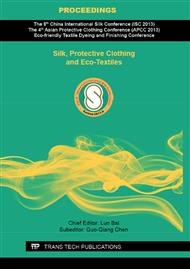p.245
p.251
p.255
p.259
p.264
p.268
p.272
p.277
p.281
Numerical Study on the Polymer Drawing of the Unsymmetrical Air Flow Field in Melt Blowing Process
Abstract:
Melt blowing is a typical nonwoven process for producing superfine fibers. In this process, the high velocity hot air jets attenuate the polymer melt into superfine fibers. Therefore, the fiber diameter is strongly affected by the air flow field. Dual slot die is one of the widely used melt blowing dies. Hot air emits from the two slots symmetrically. What will happen to the polymer drawing if the air jets are unsymmetrical In this paper, the unsymmetrical air flow field of the dual slot die in melt blowing process is simulated numerically. The distributions of air velocity and air temperature are obtained. The polymer drawing model is then solved with the aid of the simulation results of air velocity and air temperature. The diameter and transverse displacement of the threadline along the spinline is achieved. The result shows that the threadline diameter of unsymmetrical air flow field is larger than that of the symmetrical air flow field and the threadline tends to deflect because of the unsymmetrical air jets. This paper helps to indicate the research direction for further decreasing the fiber diameter of melt blown nonwoven fabrics.
Info:
Periodical:
Pages:
264-267
Citation:
Online since:
September 2013
Authors:
Price:
Сopyright:
© 2013 Trans Tech Publications Ltd. All Rights Reserved
Share:
Citation:


